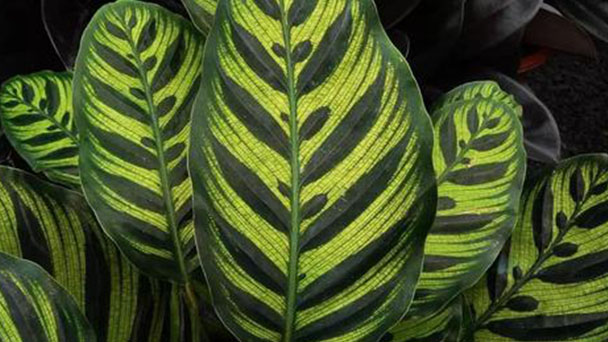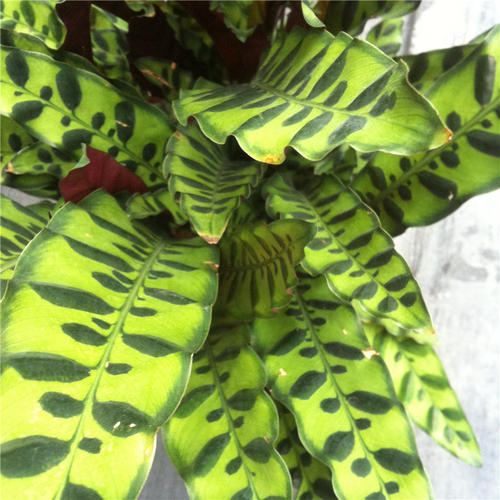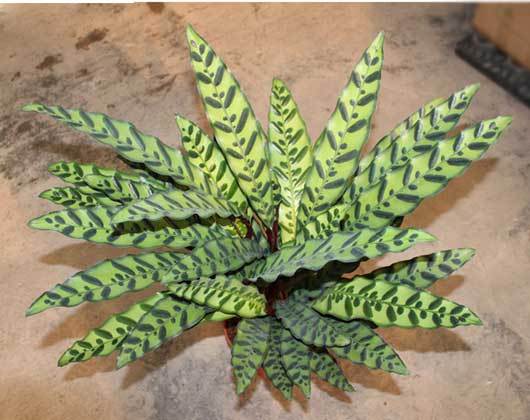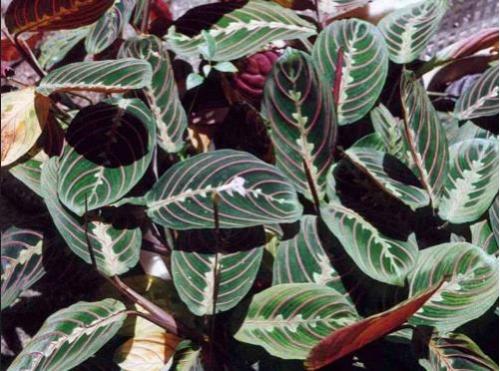Prayer plant Info: How to Grow and Care for Prayer Plant
Written by Maggie
Dec 03 2021

Prayer Plant, scientific name Maranta leuconeura, is a perennial evergreen herb foliage plant of the Araceae family. Prayer Plant height is up to 30 cm, much branched, broad and round leaves, bright light green on the front, grayish green on the back. Leaves are obovate, stalk base sheathlike. Racemes, flowers are in pairs, bracts few, sepals lanceolate; Corolla tube is cylindrical, base swollen, style thick.
Prayer Plants are made in places like Brazil. Prayer Plant loves a warm, humid and semi-shaded environment. Because this plant is resistant to shade, it is very suitable for the adornment beautification and afforestation inside the domestic bedroom. Prayer Plant can be placed for a long time inside a brighter room, appreciate and admire, 4-6 weeks is placed inside the room with darker light, grow to its also without too big effect, can be put in a darker room for a long time, so also can grow well.
Prayer Plant Picture
Prayer Plant Info
| Botanical Name | Maranta leuconeura |
| Common Names | Prayer Plant |
| Plant Type | Herbaceous perennial |
| Sun | Partial shade, full shade |
| Hardiness Zones | 11, 12 (USDA) |
| Flower color | White |
| Native Area | South America |
| Mature size | 6–12 in. tall, 6–12 in. wide |
Characteristics of Prayer Plant
Prayer Plant Strain
Prayer Plant is a perennial herb, erect or creeping, branching herb; Plant height is 10 cm to 30 cm, internode short, much branching, stem prostrate growth.
Prayer Plant Leaf
Prayer Plant leaves are round in width, 8 cm to 15 cm in length, 7 cm to 10 cm in width, heart-shaped in base, pointed in front, light green and glossy in front, 6 to 8 pairs of lateral veins, two symmetrical pinnately arranged stripes between veins, grayish-brown at the beginning, dark green at the end, grayish-green at the back. Stalk base is sheathlike.
Prayer Plant Flowers
Prayer Plant has few flowers, in pairs, arranged in a racemes, few bracts, late falling; Prayer Plant has 3 sepals, lanceolate; Corolla tube is cylindrical, base often swollen, lobes 3, nearly equal; Stamen tube is usually short, outer ring of 2 stamens petal-shaped, obovate, longer than petals, inner ring of 1 hooded appendage with an outer margin inflexed; 1 obovate hard leathery; 1 developed stamen, anther 1 locule; Ovary 1-locule, 1-ovule; Style is thick.
Prayer Plant Fruit
Prayer Plant is ovate or rectangular, nutlike, not dehiscent; Prayer Plant has 1 seed.
Prayer Plant Growing Conditions
Prayer Plants like warm, humid and bright environment, not cold or drought resistant, afraid of scorching sun exposure, should be fully watered in the growing period, to keep wet, but soil should not water, it is better to use loose, fertile, good drainage and ventilation, and rich in humus of the slightly acidic soil.
How to Grow and Care for Prayer Plant
Prayer Plant Temperature Care
The Prayer Plant is native to tropical and subtropical areas, and likes high temperature, humid and semi-shade environments. The suitable growth temperature is 20-30℃, the best growth temperature is 18-21℃ in the daytime, 16-18℃ at night, and the safe overwintering temperature is 10℃. Therefore, in summer to prevent high temperature irradiation, put it in the shade; Winter should pay attention to the cold, the plant can be moved to a windless, warmer indoor winter.
Prayer Plant Lighting Requirements
Avoid direct sunlight, Prayer Plant is better to grow below indirect radiation light or scattering sex light. Especially in summer, direct sunlight is easy to cause leaf burns, so the production is cultivated in the artificial controlled light environment with a shading net of 75%-80% refluence. If burn is found on the leaves, it should be immediately removed to a place without direct light or shading facilities or under the shade of trees, and the burned leaves should be cut off to avoid the invasion of other pathogenic bacteria from the wound. At the same time, strengthen the management of water and fertilizer, promote its re-leaf, restore a new appearance.
Prayer Plant Watering
Spring - autumn each year is the peak season of Prayer Plant, the most suitable for the growth of air relative humidity from 75% to 85%, high air humidity is advantageous to the blade. Especially during the new leaf extraction, if too dry, the new leaf edge, leaf tip are easy to dry, becoming deformed in the future. Leaves cannot recover after wilting. Therefore, in the growing season Prayer Plant need to be frequently watered, and often spray to the foliage, 3-4 times a day in summer, and in time, the best watering method is spraying foliage in the morning, noon or afternoon pouring soil surface, the whole plant watering in the evening, but we should pay attention to the soil not too sticky, too wet, otherwise easy root rot and cause disease. After entering autumn and winter, the growth of Prayer Plant slows down, and the amount of watering should be gradually reduced. According to the weather change, watering 1 times a day or 2-3 days watering 1 times, especially when the temperature is low, the soil should be kept dry, so that it is free from cold damage.
Prayer Plant Soil Requirements
Cultivation soil requires fertile, loose and good drainage, avoid soil compaction and water. Fertile humus soil and porous coarse media are often used as substrates. Generally with leaf rot soil and peat soil equal amounts of mixed configuration; Pond mud, peat and perlite can also be mixed in a ratio of 2:3:1. Or with loose foliar soil rich in organic matter plus 1/3 perlite, and then add a small amount of base fertilizer configuration.
Prayer Plant Fertilizer
According to the principle of "frequent and thin application", the compost of peanut bran and compound fertilizer or decompose compost should be applied once every 2 weeks during the growing season. The nutrient composition of fertilizer should be mainly nitrogen fertilizer, phosphorus and potash fertilizer. Because Prayer Plants are a foliage plant, the appropriate increase of nitrogen fertilizer can make the leaf color more beautiful. In addition, 0.1% solution can be prepared by urea with 46% nitrogen, and 0.2% solution can be prepared by adding potassium dihydrogen phosphate with more than 50% phosphorus and more than 30% potassium as root topdressing, which is better applied in the morning when the dew is not dry or at dusk. When spraying, fine hole sprayer should be used to spray both sides of the blade, spray 1 times a week, continuous spray 3 times, stop 1 time, and then continuous spray. Special attention should be paid to the concentration of fertilization should not be too large, otherwise it is easy to cause leaf burns resulting in fertilizer damage, and even cause plant death in serious cases. Stop fertilizing during the winter dormant period and when it gets too hot in summer.

Prayer Plant Propagation
Prayer Plant Propagation from Division
Division propagation of Prayer Plant, spring temperature about 20℃ propagation is the most ideal, but as long as the temperature, humidity is appropriate, can also be carried out throughout the year. To propagate, a sharp knife is used to cut the root blocks with stems, leaves, or buds; A small amount of propagation can be cut root blocks with stems, leaves and leaf buds directly placed in the mud basin; When a large number of breeding, should be placed on the seedbed; When the temperature and humidity do not reach the requirements, the application of film cover ;Be sure to make the temperature in the film to 20-28℃, humidity above 80%.
Prayer Plant Propagation from Cutting
Cuttage propagation generally with top tender shoots, 10-15 cm long cuttings, depending on the size of the leaves, retain a third or half of the leaves, cuttings with 500ppm Naacetic acid treatment for 2-3 seconds, can also be used indole acetic acid, indole butyric acid and ABT root powder treatment. The cuttings were inserted into the seedbed after treatment, and the spacing between the plants and rows was 5×10 cm. The top is covered with a thin film canopy, and the management method is the same as that of ramet propagation. Cuttage propagation can be carried out at any time when the temperature is not lower than 20℃. Root 30-50 days for cuttings; However, the survival rate of cuttings was not as high as that of division propagation.It's usually around 50%.
Prayer Plant Varieties
There are many varieties of Prayer Plants, but the most popular by far is the tricolor variation available at many garden centers. Prayer Plants and calathea plants are so closely associated with one another that it's not uncommon for them to be mislabeled. Within the Maranta genus, a few species are the most common:
M. leuconeuraerythrophylla: This tri-colored Prayer Plant, also called the herringbone plant, is the most common variety and features bold red veins.
M. leuconeura kerchoveana: This variety, also known as Rabbit's Tracks, has plain green leaves with two rows of darker splotches.
M. leuconeura massangeana: This variety has a darker leaf background with silvery blotches along the midrib and white leaf veins.
Disease & Pest Control of Prayer Plant
Prayer Plant has strong resistance and few diseases and insect pests, but some diseases and insect pests still occur in the process of cultivation due to poor management. Common pests mainly scale insects, red spider, etc.; The common diseases are mainly white silk and leaf spot disease.
Southern blight
The disease occurs more frequently. Occurs, the stem or leaf base close to the soil becomes brown rot, grow white silk mycelium, radiate, can spread in the rhizosphere soil, and then cause the ground part of the wither and death; The initial stage is white, the later stage becomes yellow, and the final appearance is brown or brown like rapeseed, and then causes the ground part to wither and die. The disease was more serious in summer, and the pathogen was small sclerotinia. In the soil is too wet, infertile lack of fertilizer easy to come on. Read More: Prayer Plant Yellow Leaves Causes & Solutions
Prevention and control methods: 70% pentachloronitrobenzene of 0.2% soil weight can be added to the soil to disinfect the soil; Before the formation of sclerotia, the diseased Prayer Plant was removed, the surrounding diseased soil was excavated, and new soil was added. Attention should be paid to ventilation during cultivation to prevent over-dense planting.
Leaf spot
The disease mainly harms the leaf of the Prayer Plant, but also the leaf sheath. At the beginning of the disease, the spots appear to be less than 1 mm in diameter, and then change to a reddish-brown spot about 2 mm in diameter without any halo around the spots. The disease can occur throughout the year, with two peaks in autumn and spring of the following year.At the peak of the disease, a large number of leaves can be dried up, and the planting areas with poor management, poor ventilation, over-dense cultivation, stagnant water, poor soil, insufficient shade and poor plant growth potential can cause serious harm. The disease and residual body are the source of the initial infection of the disease.
Prevention and control methods: to increase the basic fertilizer, enhance disease resistance; Remove the diseased leaves of Prayer Plant in time to reduce the source of bacteria; Before the onset of disease, start spraying 75% chlorothalonil WP 500-600 times liquid or spraying 75% chlorothalonil WP 1000 times liquid plus 70% methyl sulfur bacteria WP 1000 times liquid.
Scale insects
Scale insects are mainly mealybugs, which occur at the edge of leaves or on the back of leaves, and sometimes on the surface. They suck plant juice with the piercing suction mouthpiece, light leaf becomes yellow and aging, affects plant growth, serious withered leaves, fallen leaves, until the death of the whole plant; At the same time, the wound infected by scale insects is easily infected with the virus. Scale insects have strong reproductive capacity and can reproduce for many generations in one year. The incubation period is in May. Adult scale insects have a waxy shell, general pesticides are difficult to enter, once they occur, it is difficult to control.When the indoor cultivation is not well ventilated, it is susceptible to the harm of scale insects.
Prevention and control method: according to the occurrence of scale insects, in the nymphal peak spray. Therefore, when most nymphs hatch soon, the body surface has not yet secreted wax, shell has not yet formed, medication is still easy to kill, every 7-10 days spray 1 times, continuous spray 2-3 times. It can be used to prevent and control by spraying 40% diethoate 1000 times liquid or 50% dichlorvos 1000 times liquid or 2.5% deltamethrin 3000 times liquid. (Find more indoor plants for low light here.)
Starscream
Red spider harms plants more commonly, its small body, reddish-brown to orange, with sharp mouth needles to absorb the nutrients in the leaves, and cause the plant water and other metabolic balance imbalance, affecting the normal growth and development of plants. Red spider and so on in the high temperature and dry environment, insect reproduction quickly, serious harm.
Prevention and control method: keep the environment ventilated, make the environment humidity maintain above 40%, leaf back often spray water can control red spider reproduction. Because pesticides are difficult to kill the eggs, it is generally carried out in the adult and nymphal stage after the eggs hatch. It can be sprayed with 20% dichromatol emulsion 1000 times liquid or 40% diethoate emulsion 1000 times liquid.
Distribution Area of Prayer Plant
Prayer Plants are native to the tropical regions of America, Africa and Asia.
Prayer Plant Uses
Prayer Plant has an underground rhizome or tuber, leaves solitary, and large. In addition to the open leaf sheath at the base of the leaf and petiole, there is a significantly enlarged joint, called "leaf pillow", which has water storage cells, regulating the direction of the leaf, that is, when the water is sufficient at night, the leaf is upright, and when the water is insufficient during the day, the leaf is expanded, which is a characteristic of araceae plants.In addition, some arrowroot also 'sleep movement', that is, the leaf spread out during the day, the night folded, very peculiar. (Find more best indoor hanging plants here.)
Landscaping
The leaves of Prayer Plant are rich and colorful, highly ornamental, and most of them are shade plants with strong negative tolerance and strong adaptability. Prayer Plant can be planted in the shade of courtyards and parks or by the roadside. In South China, more and more species have been used in landscaping. Planting methods can be used in patches, clumps or with other plants.In northern areas, can be cultivated in the ornamental greenhouse for landscape ornamental.
Indoor decorate
Prayer Plant is stronger because bear negative, leaf color is beautiful, can be planted directly in the corner lot of the public place such as guesthouse, shopping mall, large assembly hall to make permanent arrangements. However, in the process of cultivation and management, it is necessary to properly supplement the light and regularly spray water to the foliage to improve the air humidity.
Potted plant leaf cutting
Because the Prayer Plant type is beautiful, the leaf color is multicoloured, and has a strong negative tolerance, cultivation management is simple, used for indoor potted ornamental, Prayer Plant is one of the most famous indoor leaf viewing plants in the world. Large breed can be used to decorate the hall of guesthouse, market, small breed can adorn the balcony of the bedroom, sitting room, bedroom, etc. In the process of cultivation and management, each placed for a period of time, should be placed in the balcony, window sill where the sun is strong, enhance the light, for long-term appreciation. Prayer Plant is a high-grade leaf cutting material and can be directly used as flower arrangement or as lining material for flower arrangement.

Read Next:
Best 20 Air Purifying House Plants Improve Your Health
Best 15 Indoor Plants for Low Light 2021
Latest Updated
- Benefits of Bugleweed - 7 Science-backed Health Benefits
- Bugleweed Dangers & Side Effects - Is It Poisonous?
- How to Plant Evergreen Trees - What You Should Know
- When to Plant Evergreens - Grow Guide for Evergreen Trees
- 12 Wonderful Evergreen Shrubs for Your Garden
- 12 Popular Evergreen Plants with Pictures for Beginners
- When And How To Prune A Lilac Bush Like a Pro
- How to Grow & Care for Lilac Vine (Hardenbergia Violacea)
- Japanese Lilac Tree (Syringa Reticulata) Care & Propagation Guide
- Shumard Oak Pros and Cons - What to Know
Popular Articles
- Winter maintenance of Antirrhinum Majus
- How to Grow Terminalia Mantaly Tree
- How to Grow and Care for Crossostephium Chinense
- How to grow Antirrhinum Majus in spring
- Peristeria Elata (Dove Orchid) Profile: Info & Care Guide
- Underwatered Snake Plant (Sansevieria Trifasciata) - Signs And How To Fix
- How to Care for Brazilian Jasmine Plant (Mandevilla Sanderi)
- How to Grow & Care for Graptopetalum Purple Delight in Summer
- Rosa Chinensis (China Rose): Plant Growing & Care Tips
- How to Care for Baby Sun Rose (Aptenia Cordifolia)
